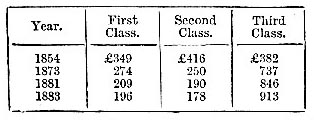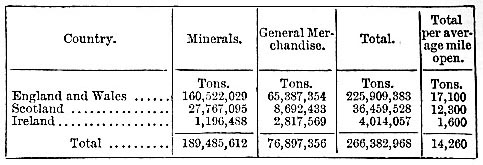1902 Encyclopedia > Railway, Railways (Railroad) > Rail Traffic. (a) Passenger Traffic. (b) Goods Traffic.
Railway, Railways
(Part 8)
B. RAILWAYS - STATISTICS (cont.)
Rail Traffic. (a) Passenger Traffic. (b) Goods Traffic.
(a) Passenger Traffic
Before the establishment of the railway from twenty to thirty coaches ran daily between Manchester and Liverpool, whereas the railway carried 700,000 passengers during its first eighteen months. Wherever railways were made the carriages of passenger was found to be one of the most remunerative sources of traffic. Nearly fifty years ago Porter, in his Progress of the Nation (1836), estimated that in Great Britain 82,000 persons daily, or 30,000,000 per annum, traveled by coach an average distance of about 12 miles each, at an average cost of 5s. for each passenger, 5d. per mile, whereas in 1881 upwards of 600,000,000 passengers travelled by railway at a cost, taking averages, of 10 1/2d. each, which at the average rate of say 1 1/4d. per mile travelled would represent an average length of 8 1/2 miles, at one-fourth of the cost and in one-third of the time required by coach.
Table X. shows the total number of passengers of each class conveyed in 1883:—

The proportions of passengers, independent of season-ticket holders, were as follows (Table XI.):—
The number of passengers conveyed in the year 1883 per mile of the mean length of railway open during the year was, in England 46,340, in Scotland 17,550, and in Ireland 7710.
The receipts from passenger traffic in 1883 are given in Table XII. (see below).

Table XII. Receipts from Passenger Traffic in 1883.
The decided preponderance of third-class traffic shown in this table is the outcome of the work of years. In 1854 upwards of 111 million passengers travelled by railway, of whom 13 per cent. travelled by first, 34 by second, and 53 by third class and parliamentary carriages. In 1873, the year before the Midland Railway Company ceased to carry second-class passengers, upwards of 455 million passengers travelled by railway, of whom only 8 1/2 per cent. travelled by first, 15 by second, and 76 1/2 by third class carriages. In 1881 upwards of 623 million passengers travelled by railway, nearly six times as may as in 1854. Of these only 6 per cent. were first and 10 1/2 second class passengers, whilst the third-class and parliamentary passengers rose to 83 1/2. Finally, in 1883 (as already stated in Table XI.), 85 per cent. of the passengers were third class. The same movement is exemplified in the receipts, the mass of receipts gravitating towards third class, as shown by the following abstract per mile open for the years already mentioned (Table XIII.):—

These figures show that in 1854 first and second class receipts together made up two-thirds of the whole receipts from passengers, but they steadily declined in succeeding years, not only proportionally but absolutely,—the third class receipts, on the contrary, exhibiting a rapid increase, insomuch that, whereas in 1854 they were exactly one-third of the whole receipts, in 1883 they amounted to more than two-thirds of the whole receipts from passengers. The reaction in first-class receipts is all the more remarkable because the number of first-class passengers in 1854—14 1/2 millions—was nearly trebled in 1873; that of 1873 was almost exactly the same as in 1881,—about 38 millions; whilst in 1883 there were nearly 36 1/2 millions. The explanation is probably to be sought partly in the fact that first-class fares have been reduced in many cases and express fares have been almost entirely abolished, and partly to the increased habit of taking third class for long journeys, so that first-class journeys, being shorter on the average, have become less remunerative to the companies than before. The third class is by far the most remunerative portion of the passenger traffic of railways; and it is difficult to understand the policy still pursued by railway companies in France, of discouraging third-class traffic. On those railways where fast trains do not take third-class passengers, or third class carriages are deterrently uncomfortable and repulsive, only those travel who travel by necessity, or to whom money is no object. On the contrary, low fares and comfortable carriages invite traffic; they may almost be said to create it,—a fact which has long been recognized by the more intelligent of railway managers. The high speed of express trains—from 45-50 miles and upwards per hour—is, of course, an additional inducement to travel. On certain lines there are only two classes of carriages, —first and third. The Caledonian Railway Company was the first to adopt, about thirty-five years ago, the system of two classes only for local main-line passenger traffic. The Great North of Scotland Railway Company opened its line in 1854 with only first and third class carriages. The Midland Railway Company, as already noticed, ceased in 1874 to run second-class carriages, at the same time readjusting and lowering the fares,—the revised rates being 1 1/2d. and 1d. respectively per mile for first and third class. The result was that in 1875 27 3/4 million passengers travelled on this railway,—nearly 5 millions more than in 1873, before the change was made; whilst in 1881 there were 29 million travellers, of whom 27 millions were third and only 2 millions first class passengers; and in 1883 upwards of 31 million passengers were carried, of whom 29 1/2 millions were of the third and a little over 1 3/4 millions of the first class. The gross receipts for passenger traffic on the Midland Railway were, in round numbers, £1,660,000 in 1873, £1,187,000 in 1881, and £1,904,000 in 1883, whilst the percentage of working expenditure remained the same. On the whole, it appears from the results of this grand experiment that the change has succeeded financially, whilst there is no doubt that it has stimulated the provision for and development of third-class traveling on other railways. The gravitation of traffic to the lowest level in unquestionable; and it is aided by the fact that third-class carriages have been (1885) for some years run with nearly all trains, fast as well as slow, and that the largeness of the number of third-class passengers has forced upon the management of the companies improvements in the popular class of carriage. As the downward movement of the classes continues the outcome will most likely be a general reduction of the number of classes to two,—nominally first and third, practically first and second. On 1st May 1885 second-class carriages were abolished on the branch lines of the Great Northern Railway; and, if the experiment answers expectations, second-class carriages will be abolished on the entire Great Northern system.
(b) Goods Traffic
The returns to the Board of Trade do not supply material for close analysis of goods traffic. The quantities of minerals and goods or general merchandise conveyed in 1883 were as follows (Table XIV.):—

The receipts from mineral and goods traffic in 1883 are given in Table XV.:—
These statistics of merchandise and mineral traffic show that upwards of 266 million tons were conveyed in 1883 in the United Kingdom, seven-tenths of which were minerals. In 1857 71 million tons were conveyed, of which only two-thirds consisted of minerals; whence it appears that a more rapid development of mineral traffic than of general merchandise took place in the interval.
Read the rest of this article:
Railway, Railways - Table of Contents
|




